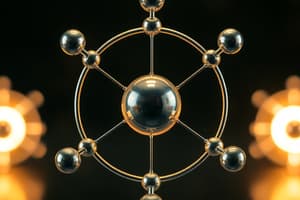Podcast
Questions and Answers
What happens to a metal atom when it transfers its electrons to a nonmetal atom?
What happens to a metal atom when it transfers its electrons to a nonmetal atom?
- It becomes a neutral atom.
- It becomes a positive ion (cation). (correct)
- It remains unchanged.
- It forms a metallic bond.
Which prefix is used to denote three atoms in a molecular compound?
Which prefix is used to denote three atoms in a molecular compound?
- Penta-
- Di-
- Tri- (correct)
- Tetra-
What characteristic do ionic compounds typically exhibit at room temperature?
What characteristic do ionic compounds typically exhibit at room temperature?
- They form a solid and are brittle. (correct)
- They are usually gaseous.
- They are soft and flexible.
- They are liquid and conductive.
How do ionic compounds behave when heated or dissolved in water?
How do ionic compounds behave when heated or dissolved in water?
In the chemical formula CO, what can be inferred about the carbon atom?
In the chemical formula CO, what can be inferred about the carbon atom?
Which of the following is a physical change?
Which of the following is a physical change?
Which sign indicates a chemical change?
Which sign indicates a chemical change?
What is the maximum number of electrons in the third energy level of an atom?
What is the maximum number of electrons in the third energy level of an atom?
What characteristic is associated with physical changes?
What characteristic is associated with physical changes?
In the Bohr model, what must be noted about filling energy levels?
In the Bohr model, what must be noted about filling energy levels?
Which statement best describes ionic compounds using the analogy provided?
Which statement best describes ionic compounds using the analogy provided?
Which of the following changes cannot usually be reversed?
Which of the following changes cannot usually be reversed?
What are valence electrons important for in an atom?
What are valence electrons important for in an atom?
What did Dalton propose about the structure of atoms?
What did Dalton propose about the structure of atoms?
What significant discovery did Thomson make about atoms?
What significant discovery did Thomson make about atoms?
According to Rutherford's model, what is primarily found in an atom?
According to Rutherford's model, what is primarily found in an atom?
In Bohr's model of the atom, how do electrons behave?
In Bohr's model of the atom, how do electrons behave?
What determines the atomic number of an element?
What determines the atomic number of an element?
What charge does a lithium ion carry after losing an electron?
What charge does a lithium ion carry after losing an electron?
What does a WHMIS symbol of a gas cylinder represent?
What does a WHMIS symbol of a gas cylinder represent?
Which of the following best describes matter?
Which of the following best describes matter?
Which of the following is an example of an intensive physical property?
Which of the following is an example of an intensive physical property?
What defines chemical properties?
What defines chemical properties?
Which of the following statements is true regarding extensive properties?
Which of the following statements is true regarding extensive properties?
Which of these properties requires a change in the substance to be measured?
Which of these properties requires a change in the substance to be measured?
Which property is a characteristic of a solid substance?
Which property is a characteristic of a solid substance?
What is one way to classify matter based on its composition?
What is one way to classify matter based on its composition?
Which of the following is an example of an extensive physical property?
Which of the following is an example of an extensive physical property?
Which of the following best describes malleability?
Which of the following best describes malleability?
Flashcards are hidden until you start studying
Study Notes
Dalton’s Model
- Atoms are tiny, solid, indivisible balls
- Atoms combine in whole number amounts
Thomson’s Model
- Atoms contain tiny, negatively charged particles called electrons
- Atoms are positively charged with electrons stuck inside
Rutherford’s Model
- Most of an atom is empty space
- The center has a small, dense core (nucleus) with a positive charge
- Electrons move around the nucleus
Bohr’s Model
- Electrons orbit the nucleus in certain paths or energy levels
Lithium Atom
- Protons: positively charged particles in the nucleus
- Neutrons: neutral particles in the nucleus
- Electrons: negatively charged particles orbiting the nucleus
Atomic Number and Mass
- The atomic number equals the number of protons in an atom
- The number of electrons equals the number of protons
- The total particles in the nucleus equal the atomic mass rounded off
- The number of neutrons equals the total particles minus the protons
Ion Charge of a Lithium Ion
- A lithium ion loses an electron
- Charge: 3 positive protons – 1 negative electron = 2+ charge
Reactions and Charges
- Alkali metals give 1 electron, so their ion charge is 1+
- Alkaline earth metals give 2 electrons, so their ion charge is 2+
- Halogens gain 1 electron, so their ion charge is 1-
- Noble gases don’t react, and their charge is 0
WHMIS
- Workplace Hazardous Materials Information System
- Warns about dangers of materials
MSDS
- Material Safety Data Sheet
Physical Properties of Matter
- Matter is anything that has mass and takes up space
- Physical properties describe what matter looks like or how it behaves without changing its chemical structure
Examples of Physical Properties
- Appearance
- Color, texture, luster
- State
- Solid, liquid, gas
- Boiling and freezing points
- Density
- Malleability
- Ductility
Types of Properties
- Intensive properties don’t depend on the amount
- Extensive properties depend on the amount
Chemical Properties
- Can only be found by changing a substance into something else
Physical Changes
- Change in the shape, size, or form of a substance, but it stays the same substance
- Examples:
- Water turning into ice
- Dissolving salt in water
- Breaking a rock
- Tearing a piece of paper
Chemical Changes
- A substance reacts and forms a completely new substance
- Examples:
- Baking bread
- Fireworks exploding
- Burning wood
- Cooking an egg
How to Tell the Difference Between Physical and Chemical Changes
- Physical changes are often reversible
- Chemical changes are usually irreversible
Bohr Models
- Used to predict reactivity in elements
Valence Electrons
- Valence electrons are electrons on the last energy level
Drawing Bohr Models
- Draw nucleus
- Write number of neutrons and protons
- Draw energy levels
- Draw electrons in energy levels
Rules for Energy Levels
- Level 1 can hold a maximum of 2 electrons
- Level 2 can hold a maximum of 8 electrons
- Level 3 can hold a maximum of 8 electrons
- Level 4 can hold a maximum of 32 electrons
- Fill one level before going onto the next
Ionic Compounds
- Metal atoms want to give away electrons
- Nonmetal atoms want to take electrons
- Metal and nonmetal atoms trade electrons
- Metal atom becomes a positive ion
- Nonmetal atom becomes a negative ion
- Ions stick together and form a solid at room temperature
- Brittle and break easily
- Conductors of electricity when heated or dissolved in water
Prefixes for Number of Atoms
- Mono: 1
- Di: 2
- Tri: 3
- Tetra: 4
- Penta: 5
- Hexa: 6
- Hepta: 7
- Octa: 8
- Nona: 9
- Deca: 10
Example
- Diphosphorus pentoxide
- Two phosphorus atoms
- Five oxygen atoms
- Chemical formula: P₂O₅
Writing Formulas for Molecular Compounds
- Not expected to write formulas for the state of the compound at room temperature
Studying That Suits You
Use AI to generate personalized quizzes and flashcards to suit your learning preferences.




